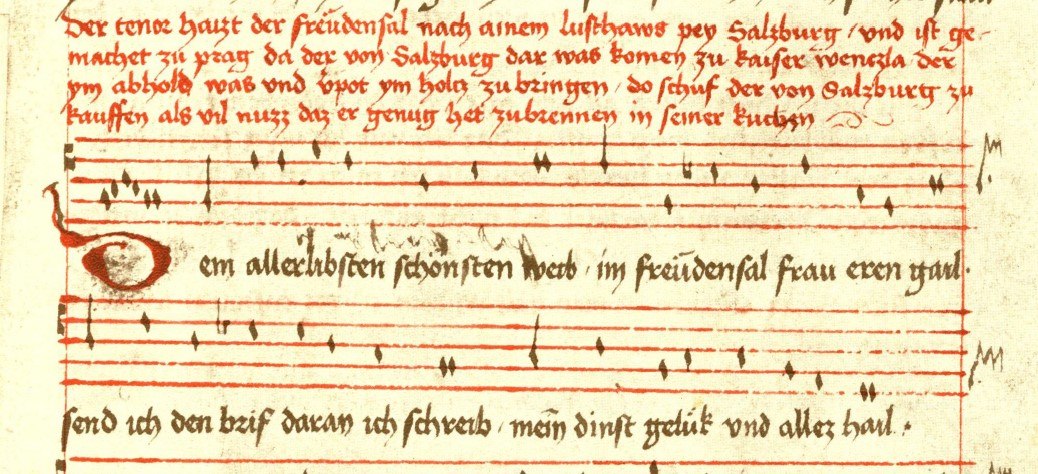Der Hof in den Liedern des Mönchs
The historical court of the Archbishop of Salzburg has its literary-musical echo in a number of the Monk’s songs. One of the most interesting of these is W19, Wier, wier der fünfzehent an der schar, which, on behalf of all the members of the court, addresses all the women who have injured them. Imitating exactly the form of a charter, from the introductory formula to the place and date at its end, Wier, wier is typical of the ingenious and playful approach to song-writing in Salzburg. Proposed by Franz Viktor Spechtler to have been composed at the Reichstag in Nuremberg in 1387, it is above all interested in the responsibilities of the good member of the courtly society,
Gesellschaft ist also gericht,
Das kain artikel sey nicht pricht.
Ein schalkch verirret gar die slicht;
Wie wol sölich dingk durch guet geschicht,
der volg yem unnser keiner gicht;
Den süll wir hassen vestiklich,
Wenen wir sein purgersinn unstët (Str. 2, 5–11)
(Courtly society is so inclined that it breaks no article of faith. A trouble-maker confuses the flow of things. However easily such a thing could happen for the best of reasons, no one among us will follow such a canker. We should instead hate him with passion, if we think his civic sense is insecure.)
Those, the song goes on, who are inconstant will not be allowed into the council. The courtly society is one that depends on trust. Where elsewhere (as in Ich klag dir, traut gesell) the songs play through notions of loyalty under the guise of the amatory relationship, in Wier, wier, the importance of trust to one’s social standing is discussed more or less openly here. While the amatory metaphor (one that reaches back to the earliest days of Minnesang in the twelfth century; see » B. Minnesang und alte Meister) is evoked at the beginning of W19, this song is all about standards in public life and conformity to conventions, something underscored in playful fashion by its already mentioned imitation of a charter.
One of the most commented pieces in the Monk’s secular corpus, Der frëudensal: Dem allerlibsten schönsten weib (W7), which takes the form of a letter to “frau Erengail” (Lady Greedy-for-Honour) is dated to carnival (Fastnacht) 1392. The supposed writer describes himself in the piece as “pilgreim”, a play on the name of the Archbishop that fed the idea, now generally abandoned, that Pilgrim von Puchheim was himself the Monk.[17] This connection to the prelate is made all the more concrete by the rubric appended to the poem in MS D (A-Wn Cod. 2856), f.190r. It describes the occasion for the apparent composition of the song Dem allerlibsten schönsten weib, the tenor of which it calls “Der Freudensaal”, during a visit by Pilgrim von Puchheim to the King of the Romans Wenceslaus IV in Prague. (See » Fig. Der tenor haizt der freudensaal: Monk of Salzburg)
Der tenor haizt der Frëudensal nach ainem lusthaws pey Salzburg, und ist gemacht zu Prag, da der von Salzburg da was komen zu kaiser Wenczla, der ym abhold was und verpot ym holz zu bringen. do schuf der von Salzburg zu kauffen als vil nuzz, daz er genug het zu brennen in seiner kuchen. (D, f. 190r)
(This tenor is called ‘The House of Joy’, after a pleasure house near Salzburg, and was made in Prague, when the Salzburger (sc. Archbishop Pilgrim) had gone there to see Emperor Wenceslas, who was unkind to him and forbade anyone to bring him wood. So the Salzburger required so many nuts to be bought that he would have enough to burn in his kitchen.)
The most extensive of any of the rubrics in the manuscript, it alleges that the song was composed in Prague, although Pilgrim is not recorded as having visited the city that year. Whether accurate or not, the rubric responds to the reality effects written into the song text and offers the fifteenth-century user a substitute connection with the fourteenth-century events described.
[17] On Pilgrim as the Monk, see Petzsch 1984, 23–24. Romuald Bauerreiß, by contrast, proposed the Abbot of St Peter’s Abbey, Johannes Rozzes to have been the Monk. See Baurreiß 1934, 204–20.
